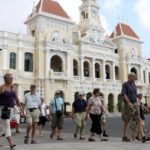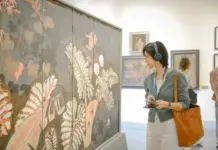Building a popular and noteworthy agritourism attraction for Hanoi residents and tourists from surrounding areas took a lot of effort, said Ngo Kieu Oanh, founder and operator of Ba Vi Homestead, one of the successful models for developing agro-rural tourism in Van Hoa Commune, Hanoi’s rural Ba Vi District.
“We have designed tours that take guests on a cultural exploration of the four Muong and Yao handicraft villages. The attractiveness of agritourism sites is influenced by their intangible values,” Oanh told The Hanoi Times.
“The development of agritourism requires flexibility and diverse tourism products, and I thought it was important to develop tourism related to natural resources and handicraft villages that involve local communities,” Oanh stressed.
|
Visitors enjoy fishing at Ba Vi Homestead. Photo courtesy of the homestay |
Meanwhile, Phung Tan Nhi, Deputy Secretary of the Van Hoa Commune Party Committee, told The Hanoi Times that the commune is striving to become an attractive agricultural and rural tourism destination. “However, the agritourism model has been fragmented, small-scale, and not properly evaluated and monitored,” Nhi said.
Le Khac Nhu, Head of Ba Vi District’s Department of Culture and Information, who is committed to the vigorous development of agro-rural tourism, suggested that there should be a rural human resources policy that focuses on the vocational transformation of local young people to join the economic activities of the locality, as well as ensuring the safety of tourists.
Hanoi has set a target for 2022-2025 that each locality with agricultural and rural tourism potential will have at least one to three community-based tourism services and tourist attractions with the participation of farmers, cooperatives, households, and businesses.
Under the plan, the city will focus on piloting six agricultural and rural tourism development models towards green, responsible, and sustainable tourism in Thuong Tin, Dan Phuong, Thanh Tri, My Duc and Thach That districts, and Son Tay Town.
This plan simultaneously develops agrotourism and contributes to the construction of new-style rural areas.
The city also aims to build vocational skills for at least 80% of workers in the restaurant and hospitality sector and tourist handicraft villages, as well as managers and enterprises in agriculture and rural tourism. To achieve these goals, Hanoi will review agrotourism and support the development of community-based tourist destinations linked to traditional craft villages and agro-industries.
 |
|
Tourists visit Hong Van Commune’s ecotourism site in Hanoi’s Thuong Tin District. Photo: Hoai Nam/The Hanoi Times |
The city’s Department of Tourism will be in charge of evaluating the performance of agricultural and rural tourism in terms of green and sustainable growth in the capital’s villages.
Tran Trung Hieu, deputy director of the department, said Hanoi’s ecological, natural, and cultural diversity, as well as its favorable location, are the advantages for Hanoi’s tourism to take off.
“With more than 800 handicraft villages in Hanoi, rural tourism is considered a gold mine for the capital’s tourism. The city’s vast suburbs, with a wealth of tangible and intangible heritage and beautiful landscapes, hold a lot of potential for the development of agricultural and rural tourism,” Hieu told The Hanoi Times.
Hanoi has 11 eco-agricultural farms operating under the model of educational and experiential tourism, and four engaged in agro-tourism, including Long Viet Agricultural Park (Soc Son District), Ba Vi Country Farm (Ba Vi District), Van An School Farm (Thanh Tri District), and Phuc Tho Hoa Bay Ecological Garden (Phuc Tho District).
“However, there needs to be more linkages between rural tourism sites and travel companies in building and upgrading products and attracting tourists. To avoid service overload, tourism sites should keep in mind that the development of services should be proportional to the number of visitors,” Hieu said.
According to Dang Huong Giang, Director of the Hanoi Tourism Department, Hanoi will expand the model of agricultural and rural tourism in many localities and develop it more systematically and professionally.
“Many localities in Hanoi have combined the development of agro-rural tourism with the construction of new rural areas. The city has two villages whose products have been recognized by the “One Commune One Product” program in the categories of community-based tourism, eco-tourism, and tourist sites, including Hong Van Village of Ornamental Creatures (in Hong Van Commune, Thuong Tin District) and Phu Dong Green Park Ecological Zone (in Phu Dong Commune, Gia Lam District),” Giang said.
She added that Hanoi has recognized seven tourist sites in suburban areas related to agro-rural tourism, handicraft villages, and ecotourism, including Duong Xa Relic Site and Phu Dong Green Park in Gia Lam District, Thuy Ung Horn Carving Village and Van Diem Wood Carving Village in Thuong Tin District, Dai Ang and Yen My tourist sites in Thanh Tri District, and Long Ho tourist site in Kim Son Commune, Son Tay Town.
“Agro-rural tourism is considered a key product that can become the spearhead to attract tourists to stay longer in the capital,” Giang stressed.
Ancient house in Ma May
NDO – Ma May, a rare quarter that still retains several old houses, has created one of the characteristics of Hanoi. Hanoi’s streets are becoming increasingly crowded and traditional features can sometimes be hidden behind modern life. But if one takes the time to relax and look around, the ancient features begin to reveal themselves.
Hanoi, HCM City see good growth of tourism revenue
NDO – In the first ten months of 2016, the revenue of Ho Chi Minh City’s tourism industry amounted to VND80 trillion while Hanoi’s reached over VND50 trillion.









